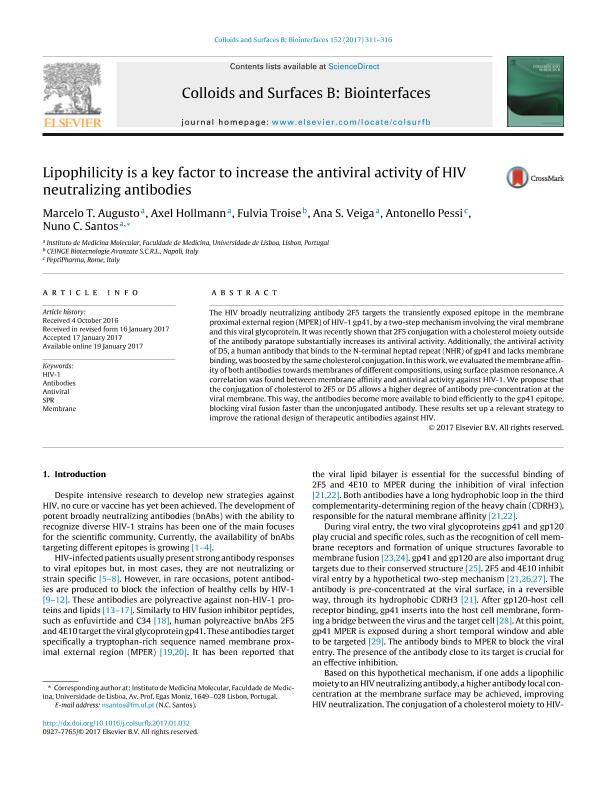Artículo
Lipophilicity is a key factor to increase the antiviral activity of HIV neutralizing antibodies
Augusto, Marcelo T.; Hollmann, Axel ; Troise, Fulvia; Veiga, Ana S.; Pessi, Antonello; Santos, Nuno C.
; Troise, Fulvia; Veiga, Ana S.; Pessi, Antonello; Santos, Nuno C.
 ; Troise, Fulvia; Veiga, Ana S.; Pessi, Antonello; Santos, Nuno C.
; Troise, Fulvia; Veiga, Ana S.; Pessi, Antonello; Santos, Nuno C.
Fecha de publicación:
04/2017
Editorial:
Elsevier Science
Revista:
Colloids and Surfaces B: Biointerfaces
ISSN:
0927-7765
Idioma:
Inglés
Tipo de recurso:
Artículo publicado
Clasificación temática:
Resumen
The HIV broadly neutralizing antibody 2F5 targets the transiently exposed epitope in the membrane proximal external region (MPER) of HIV-1 gp41, by a two-step mechanism involving the viral membrane and this viral glycoprotein. It was recently shown that 2F5 conjugation with a cholesterol moiety outside of the antibody paratope substantially increases its antiviral activity. Additionally, the antiviral activity of D5, a human antibody that binds to the N-terminal heptad repeat (NHR) of gp41 and lacks membrane binding, was boosted by the same cholesterol conjugation. In this work, we evaluated the membrane affinity of both antibodies towards membranes of different compositions, using surface plasmon resonance. A correlation was found between membrane affinity and antiviral activity against HIV-1. We propose that the conjugation of cholesterol to 2F5 or D5 allows a higher degree of antibody pre-concentration at the viral membrane. This way, the antibodies become more available to bind efficiently to the gp41 epitope, blocking viral fusion faster than the unconjugated antibody. These results set up a relevant strategy to improve the rational design of therapeutic antibodies against HIV.
Palabras clave:
Antibodies
,
Antiviral
,
Hiv-1
,
Membrane
,
Spr
Archivos asociados
Licencia
Identificadores
Colecciones
Articulos(SEDE CENTRAL)
Articulos de SEDE CENTRAL
Articulos de SEDE CENTRAL
Citación
Augusto, Marcelo T.; Hollmann, Axel; Troise, Fulvia; Veiga, Ana S.; Pessi, Antonello; et al.; Lipophilicity is a key factor to increase the antiviral activity of HIV neutralizing antibodies; Elsevier Science; Colloids and Surfaces B: Biointerfaces; 152; 4-2017; 311-316
Compartir
Altmétricas



